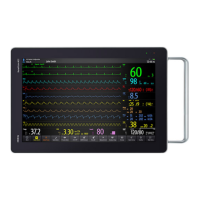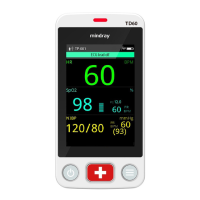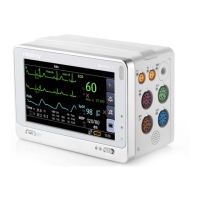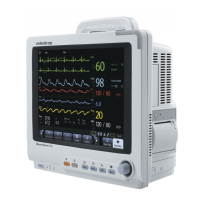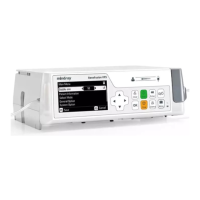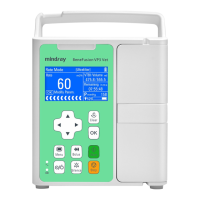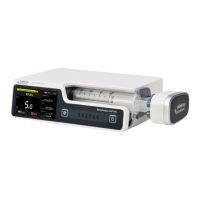7 - 6 BeneVision N1 Patient Monitor Operator’s Manual
You can also change the patient’s paced status from the Patient Management dialog. For more information, see
4.2.1Entering the Patient Management Menu.
If you did not set the paced status, the monitor issues a prompt tone when pace pulse is detected. At the same
time, the paced symbol flashes and the message Please check if the patient has a pacemaker? appears in
the ECG waveform area. Check and set the patient’s paced status.
• For paced patients, you must set Paced to Yes. If it is incorrectly set to No, the monitor could mistake
a pace pulse for a QRS complex and fail to alarm when the ECG signal is too weak. On ventricular
paced patients, episodes of ventricular tachycardia may not always be detected. Do not rely entirely
upon the system’s automated arrhythmia detection algorithm.
• False low heart rate or false asystole alarms may result with certain pacemakers because of
pacemaker artifacts, such as electrical overshoot of the pacemaker overlapping the true QRS
complexes.
• Do not rely entirely on rate meter alarms when monitoring patients with pacemakers. Always keep
these patients under close surveillance.
• The auto pacer recognition function is not applicable to pediatric and neonatal patients.
7.4.7 Enabling Pacer Rejection
The pace pulse rejection function is disabled by default. To enable this function, follow this procedure:
1. Select the ECG numeric area or waveform area to enter the ECG dialog.
2. Select the Pacer tab.
3. Switch on Pacer Reject.
• When pace pulses are detected, the pace pulse markers “|” are shown on the ECG waveforms. Pacer
Rejection setting has no impact on the display of pace pulse markers “|”.
• You can switch on pacer rejection only when Paced is set to Yes. If Paced is set to no, the Pacer Reject
function is disabled.
7.5 Changing ECG Settings
7.5.1 Choosing an ECG Screen
When monitoring ECG, several display options are available.
■ For 3-lead ECG monitoring, only normal screen is available.
■ For 5-lead ECG monitoring, besides the normal screen, you can also choose Full-screen (7-lead).
■ For 6-lead ECG monitoring, besides the normal screen, you can also choose Full-screen (8-lead).For 12-lead
ECG monitoring, besides the normal screen, you can also choose Full-screen (7-lead), or 12-Lead (12-lead
analysis).
To choose the desired screen configuration, follow this procedure:
1. Select the ECG numeric area or waveform area to enter the ECG dialog.
2. Select Full-Screen, or 12-Lead when visible.
To return to the normal screen, press the highlighted button to unselect that screen.
Alternately you can choose the desired screen configuration as follows:
1. Select the Screen Setup quick key → Choose Screen or select the Main Menu quick key → from the
Display column select Choose Screen.
2. Select ECG Full-Screen, or ECG 12-Lead.
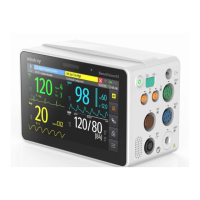
